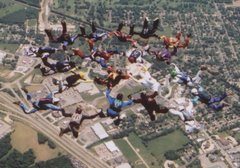Valerie and I are going to a blues festival downtown this
afternoon. We’re going to see Dave Black, Leroy Pierson and the St. Louis
Social Club. They are all friends of ours, and all were part of the great
Broadway Oyster Bar 80s music scene.
The place was half as big as it is now.
There was no heat in the winter. We had two fireplaces and
threw sleeping bags over the doors. Stains on them gave an uncomfortable
impression. If you brought a log, you got a free drink.
There was no AC in the summer. I used to set a bus pan full
of ice on the bar with a fan behind it. We had to close for two weeks every
year when the heat got unbearable. That’s when I went on some of the greatest
travel adventures of my life.
Thursday nights was Tommy Bankhead and the Blues Eldoradoes.
Tommy was a legend.
He had backed musicians such as Howlin'
Wolf, Sonny Boy Williamson, Elmore James (his cousin), Joe
Willie Wilkins, Robert Nighthawk, and Joe Hill Louis.
My first encounter with Tommy was when I was 17 at a small
bar called Sadie’s Personality Lounge on north Union . I
told the story in one of my first posts.
Sadie’s was part of the actual Chitlin’ Circuit. The place
was so outside of the law, cops wouldn’t go near the place. No one even blinked
at the fact that my friends and I were obviously minors.
I had to get over my uptight, repressed bullshit as soon as
I walked in the door. A three hundred pound Vietnam
vet, who had lost both arms, grabbed me with a claw and pulled me into the
dance floor. I looked around the room and decided, “I’m gonna dance!”
My friend Freddy talked us into coming. He was jamming with
the band. At one point, he handed me his guitar and said, “Play with Tommy.”
I was playing away when I looked over at Tommy. He asked,
“You went to music school, didn’t you?” I was crushed. I couldn’t get off the
stage fast enough.
I haven’t had the balls to jam spontaneously since. I really
regret it because I was asked to sit in with Chuck Berry once at the Oyster
Bar.
Years later I told Tommy the story. He didn’t remember it at
all, but he thought it was funny. I used to change the name of the bands. I
called them Tommy Bunk Bed and the Blue Avocados. Tommy didn’t think that was
funny.
The best sax player I’ve ever seen anywhere was in Tommy’s
band. “Big” Joe Enloe. There’s just no way to describe him. He just made life
bearable. If you walked in while they were playing, he made laughing sounds
through his horn and you just had to laugh. Out of nowhere he tongued his reed
and it sounded like the Roadrunner. The man lived and breathed through his
horn.
Dominic asked him for lessons. He said, “Man, you can’t
teach this!”
When he died, he had one of the most incredible services
I’ve ever been to in East St. Louis .
I can’t begin to go through the list of Blues luminaries who arrived. Everyone
was there.
Tommy’s drummer Ben Wells cried like a baby. I don’t think
anyone in the band ever got over it. They were never the same after that.
Mark O'Shaughnessy (owner of BBs Blues and Soups) told me he
got an 8 track recording of the band at Mississippi Nights with Joe. It’s
become one of those mythical projects that have disappeared into the ether.
The Blues Eldoradoes came out with an LP about a year later,
but they just didn’t capture what they were live. Joe was really missing.
Tommy was a sheriff for the City of St.
Louis . He used to transport prisoners. It was strange
running into him on the street. A cop’s uniform just didn’t fit his outlaw
nature.
When my friend Sharon and I would count our cash register
receipts at the end of the night in the back room, Tommy would show up knocking
on the window while his Lincoln
idled behind him. He wanted to party on the East Side . I
was welcome, as long as the girls were with me.
At the end of his life, he became revered as one of the
greats. BBs still has giant posters of Tommy papering the walls. Tommy would
show up wheeling a canister of oxygen behind him.
He died in December 2000 from respiratory
failure due to emphysema. I found out about it on NPR. He had become
a national figure.




